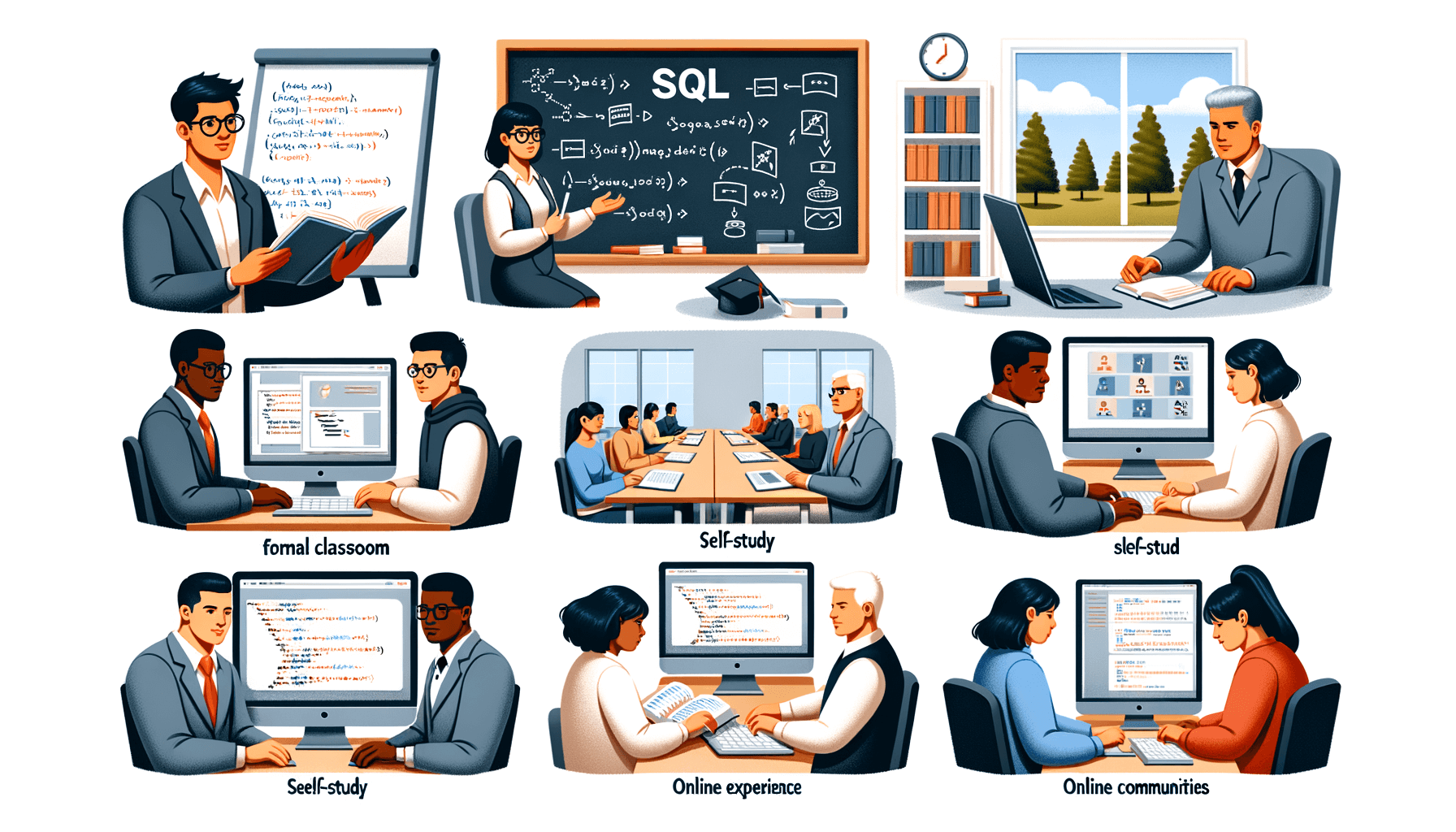A big variety of articles and resources

Learn SQL Basics for Data Science Specialization: A Comprehensive Guide
 Sia Author and Instructor
Learn SQL
Sia Author and Instructor
Learn SQL
10 minute read
SQL, or Structured Query Language, is a key tool for anyone working in data science. It's used to manage and analyze data stored in databases. This guide will help you learn the basics of SQL and show you how it's used in real-world data science projects. Whether you're new to SQL or looking to refresh your skills, this guide has something for you.
Key Takeaways
- SQL is essential for managing and analyzing data in data science.
- Understanding basic SQL queries like SELECT, INSERT, UPDATE, and DELETE is crucial.
- Advanced SQL techniques, such as joins and window functions, are important for complex data tasks.
- Using the right SQL tools and environments can make your work more efficient.
- Ethical considerations and data security are important when working with SQL.
The Importance of SQL in Data Science
Role of SQL in Data Management
SQL is a cornerstone in data management. It helps us store, retrieve, and manipulate data efficiently. Without SQL, handling large datasets would be a nightmare. We can easily query databases to find the information we need, making our work faster and more accurate.
SQL vs. NoSQL: A Comparative Analysis
When comparing SQL and NoSQL, it's important to understand their differences. SQL databases are structured and use tables, while NoSQL databases are more flexible and can handle unstructured data. Each has its own strengths, but for most data science tasks, SQL's structured approach is more beneficial.
Real-World Applications of SQL in Data Science
In the real world, SQL is used in various data science applications. From analyzing sales data to predicting trends, SQL helps us make sense of large datasets. We can join tables, filter results, and perform complex calculations, all with simple SQL queries.
SQL is not just a tool; it's a skill that empowers us to turn raw data into meaningful insights.
Fundamental SQL Concepts for Data Science
Understanding Databases and Tables
In data science, we often work with large sets of data stored in databases. A database is like a digital filing system where data is organized into tables. Each table holds information in rows and columns, making it easy to find and use. Understanding how databases and tables work is crucial for managing and analyzing data effectively.
Basic SQL Queries: SELECT, INSERT, UPDATE, DELETE
SQL, or Structured Query Language, is the tool we use to interact with databases. The most common SQL commands are SELECT, INSERT, UPDATE, and DELETE. These commands help us retrieve, add, change, and remove data from tables. For example, the SELECT command lets us pull specific data from a table, while the INSERT command allows us to add new data.
Data Types and Constraints in SQL
When we create tables in a database, we need to define the type of data each column will hold. These are called data types, and they include things like numbers, text, and dates. Constraints are rules we set to make sure the data is accurate and reliable. For instance, we might use a constraint to ensure that a column only accepts unique values.
Mastering these fundamental SQL concepts is like building a strong foundation for a house. It prepares us for more advanced topics and helps us solve real-world problems efficiently.
Advanced SQL Techniques for Data Science
Joins and Subqueries: Combining Data Efficiently
In data science, we often need to combine data from multiple tables. Joins and subqueries are essential tools for this task. Joins allow us to merge rows from two or more tables based on a related column. Subqueries, on the other hand, let us nest one query inside another, providing a way to perform more complex operations. Mastering these techniques can significantly enhance our ability to handle large datasets.
Window Functions for Advanced Data Analysis
Window functions are powerful for performing calculations across a set of table rows related to the current row. Unlike aggregate functions, they do not collapse the result set. This makes them ideal for running totals, moving averages, and ranking. By using window functions, we can gain deeper insights into our data without losing the context of individual rows.
Using SQL for Data Cleaning and Transformation
Data cleaning and transformation are crucial steps in any data science project. SQL provides a robust set of tools for these tasks. We can use SQL to remove duplicates, handle missing values, and transform data into the required format. This process ensures that our data is accurate and ready for analysis. A well-structured SQL query can make data cleaning more efficient and less error-prone.
In our mini course: SQL Query Expansion, designed for senior database engineers, we cover advanced topics like UNION, MIN, MAX functions, scalability, and integration. This practical, expert-led training helps in mastering complex database functions and leadership skills through challenge-based learning.
SQL Tools and Environments for Data Science
Popular SQL Databases: MySQL, PostgreSQL, SQLite
When it comes to SQL databases, we have several popular options to choose from. MySQL, PostgreSQL, and SQLite are among the most widely used. MySQL is known for its speed and reliability, making it a favorite for web applications. PostgreSQL, on the other hand, is celebrated for its advanced features and compliance with SQL standards. SQLite is a lightweight database, perfect for small projects and embedded applications.
SQL Integrated Development Environments (IDEs)
To write and manage SQL queries efficiently, we often use Integrated Development Environments (IDEs). These tools provide a user-friendly interface and additional features like syntax highlighting, code completion, and debugging. Some popular SQL IDEs include:
- DBeaver: A universal database tool that supports various databases.
- SQL Workbench/J: A free, DBMS-independent, cross-platform SQL query tool.
- pgAdmin: A comprehensive PostgreSQL database management tool.
Cloud-Based SQL Solutions for Data Science
In recent years, cloud-based SQL solutions have gained popularity. These platforms offer scalability, flexibility, and ease of use. Some notable cloud-based SQL solutions are:
- Google BigQuery: A fully-managed, serverless data warehouse that enables super-fast SQL queries.
- Amazon Redshift: A fast, scalable data warehouse that makes it simple and cost-effective to analyze data.
- Microsoft Azure SQL Database: A managed cloud database that offers high availability and security.
Leveraging the right SQL tools and environments can significantly enhance our data science workflows, making data management and analysis more efficient and effective.
Optimizing SQL Queries for Data Science
When we work with SQL, optimizing our queries is crucial for improving performance and efficiency. By focusing on indexing and query optimization, we can significantly reduce the time it takes to retrieve data from our databases. Here are some key strategies we can use:
- Use Indexes: Indexes help speed up data retrieval. We should create indexes on columns that are frequently used in WHERE clauses or as join keys.
- **Avoid SELECT ***: Instead of selecting all columns, we should specify only the columns we need. This reduces the amount of data processed and returned.
- Limit Results: Using the LIMIT clause can help us retrieve only the necessary rows, which is especially useful during testing.
- Analyze Query Plans: We can use tools to analyze how our queries are executed. This helps us identify bottlenecks and optimize our SQL statements.
| Strategy | Description |
|---|---|
| Use Indexes | Speed up data retrieval by indexing key columns. |
| Avoid SELECT * | Specify only needed columns to reduce data load. |
| Limit Results | Use LIMIT to fetch only necessary rows. |
| Analyze Query Plans | Identify performance issues through execution plans. |
By following these practices, we can ensure that our SQL queries run efficiently, allowing us to focus on data analysis and insights rather than waiting for results.
In conclusion, performance tuning is an essential part of working with SQL in data science. By applying these techniques, we can enhance our data handling capabilities and improve our overall workflow. We should always strive to write efficient SQL code to make our data science projects more successful.
Integrating SQL with Data Science Workflows
SQL and Python: A Powerful Combination
When we combine SQL with Python, we unlock a powerful toolset for data analysis. Python libraries like Pandas and SQLAlchemy allow us to seamlessly interact with databases, making data manipulation straightforward. This integration helps in efficient data preparation, improved data quality, and project readiness with AI assistance.
Using SQL with R for Data Analysis
R is another popular language in data science, and it works well with SQL. By using packages like RSQLite and dplyr, we can easily query databases and manipulate data frames. This combination is particularly useful for statistical analysis and visualization.
SQL in Machine Learning Pipelines
Incorporating SQL into machine learning workflows can streamline data preprocessing and feature engineering. By using SQL queries, we can efficiently filter, aggregate, and join datasets, which are essential steps in preparing data for machine learning models. This approach ensures that our data is clean and well-structured before feeding it into algorithms.
Integrating SQL with our data science workflows not only enhances our analytical capabilities but also ensures that our data is well-organized and accessible.
Ethical Considerations and Data Security in SQL
Data Privacy Laws and Regulations
In our work with SQL, we must always be aware of data privacy laws. These laws help protect people's personal information. We need to follow these rules to keep data safe and respect users' rights. For example, users should be able to access and modify their data easily.
Implementing Data Security Measures in SQL
To keep data secure, we use several methods. These include encryption, access controls, and regular audits. Encryption makes data unreadable to unauthorized users. Access controls ensure only the right people can see or change data. Regular audits help us find and fix any security issues.
Ethical Data Handling Practices
We must handle data ethically. This means being honest about how we collect, use, and share data. We should also let users know about any changes to our data security measures. By doing this, we build trust and show that we care about their privacy.
When working with SQL, it's important to think about ethics and keeping data safe. Always make sure your data is protected and used in the right way. Want to learn more about how to handle data responsibly? Visit our website and check out our courses!
Conclusion
In conclusion, learning SQL is a crucial skill for anyone interested in data science. This guide has covered the basics, from understanding databases to writing your own queries. By mastering these fundamentals, you can analyze data more effectively and make better decisions based on your findings. Remember, practice is key to becoming proficient in SQL. Keep experimenting with different queries and datasets to deepen your understanding. As you continue your journey in data science, the skills you've gained here will serve as a strong foundation for more advanced topics. Happy querying!
Frequently Asked Questions
What is SQL and why is it important for data science?
SQL, or Structured Query Language, is used to manage and manipulate databases. It's important for data science because it helps in storing, retrieving, and analyzing data easily.
How is SQL different from NoSQL?
SQL databases are structured and use tables, while NoSQL databases can be unstructured and use different formats like documents or key-value pairs. SQL is great for complex queries, whereas NoSQL is better for flexible, scalable data storage.
What are some real-world uses of SQL in data science?
In data science, SQL is used for cleaning data, combining datasets, and making complex queries to find patterns and insights. It's also used in creating reports and dashboards.
What basic SQL commands should I learn first?
Start with the basic commands like SELECT, INSERT, UPDATE, and DELETE. These commands help you retrieve, add, change, and remove data in a database.
Can SQL be used with programming languages like Python and R?
Yes, SQL can be easily integrated with programming languages like Python and R, making it powerful for data analysis and machine learning tasks.
How can I make my SQL queries run faster?
To make SQL queries run faster, you can use indexing, write efficient code, and optimize your queries. It's also important to regularly check the performance of your database.
Related Articles

Can a programmer master SQL in a week?
13 minute read

Do I still need to learn SQL if I already know Python?
13 minute read

How did you learn SQL? Did you have a teacher?
14 minute read




